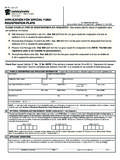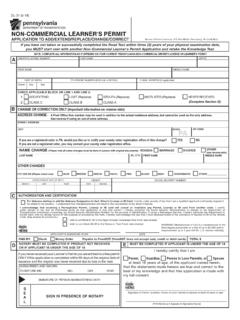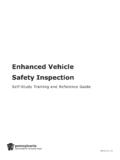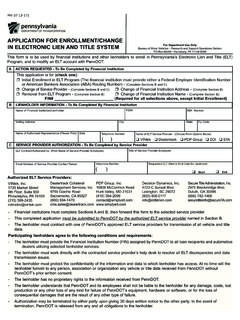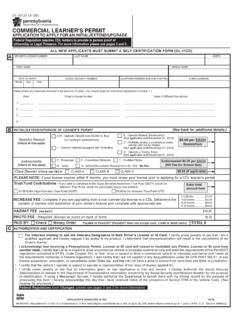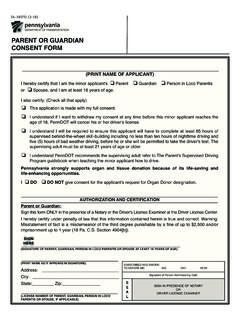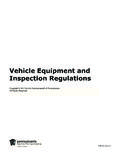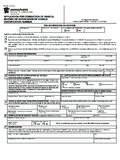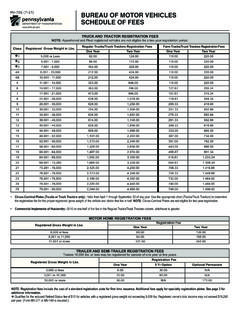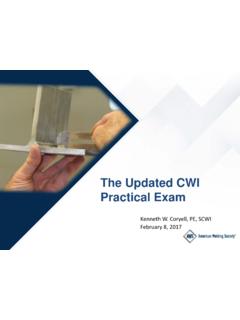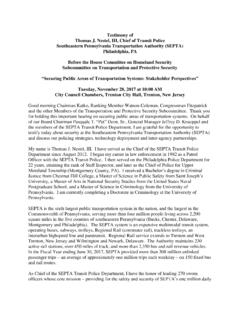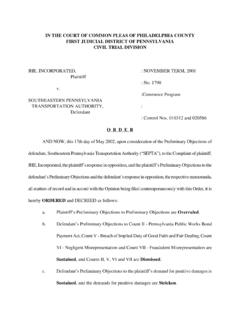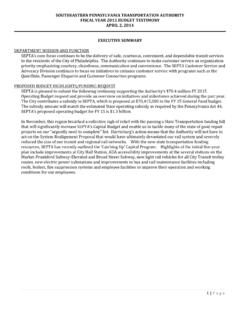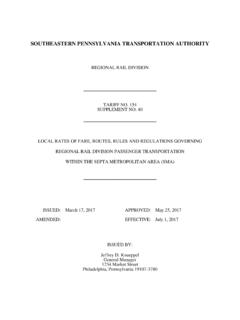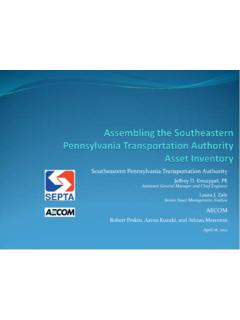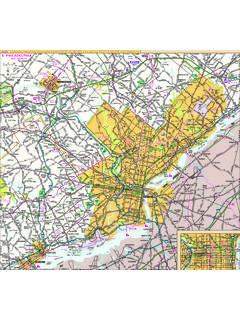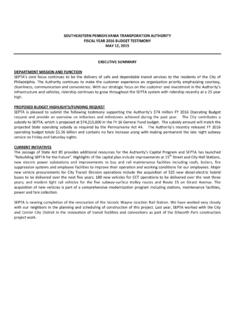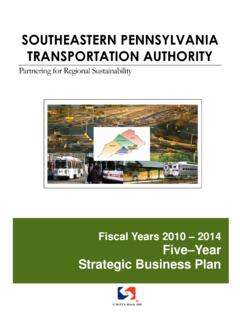Transcription of TASK FORCE SUMMARY REPORT - dot.state.pa.us
1 TASK FORCE SUMMARY REPORT Prepared for: southeastern pennsylvania transportation authority and Berks Area Reading transportation authority By: Urban Engineers, Inc. In association with: STV, Inc. AECOM Consulting transportation Group Simone Collins Landscape Architecture NOVEMBER 2007 Schuylkill Valley Metro Task FORCE i Table of Contents 1 1 PROJECT 1 PROJECT 2 FORMATION OF TASK 3 2 PRELIMINARY SCREENING AND 3 TASK FORCE SELECTION OF PREFERRED LONG RANGE 3 SCHUYLKILL VALLEY RAIL 6 3 TECHNICAL 8 STEP ONE SCREENING 9 OPTIONS 9 SUMMARY OF 9 TASK FORCE SELECTION OF PROJECT 11 STEP TWO USER BENEFITS 12 DESCRIPTION OF 12 CAPITAL 14 OPERATING AND MAINTENANCE 16 RIDERSHIP AND 17 TRANSIT USER 18 SUMMARY OF 19 SEGMENTATION 20 OPTIONS 20 SUMMARY OF 21 4 CONCLUDING 22 RIDERSHIP 23 THE DVRPC 23 THE BERKS COUNTY 23 PROJECT 24 FUNDING 24 Appendices: A.
2 Schematic Diagrams of Initial Screening Alternatives B. Schematic Diagrams of Step One Options C. Schematic Diagrams of Step Two Options D. Schematic Diagrams of Segmentation Options Schuylkill Valley Metro Task FORCE ii List of Exhibits Exhibit 1 - MetroRail Service Plan .. 2 Exhibit 2 - Initial Screening Alternatives .. 4 Exhibit 3 - Schematic Diagram of Selected Project Configuration .. 5 Exhibit 4 - SUMMARY of Schuylkill Valley Rail Assessment .. 7 Exhibit 5 - Step One Service Options .. 9 Exhibit 6 - SUMMARY of Step One Analysis Results .. 10 Exhibit 7 - Key Step One Observations .. 11 Exhibit 8 - SUMMARY of Step 2 Capital Costs .. 16 Exhibit 9 - SUMMARY of Step 2 Annual Operating 16 Exhibit 10 - SUMMARY of Daily Boardings .. 17 Exhibit 11 - SUMMARY of User Benefit Results .. 19 Exhibit 12 - Selected Rail Projects in Preliminary 19 Exhibit 13 - SUMMARY of Segmentation Analysis 22 Schuylkill Valley Metro Task FORCE 1 1 INTRODUCTION The purpose of this REPORT is to describe and summarize the work performed for the Governor's Task FORCE , which was formed in 2004 to review and evaluate possible ways to restructure the Schuylkill Valley Metro project so that it could be implemented in a timely manner within funding constraints.
3 PROJECT HISTORY In 1998 the southeastern pennsylvania transportation authority (SEPTA) and the Berks Area Reading transportation authority (BARTA) completed a feasibility study to determine the viability of using existing rail rights-of-way for new rail passenger service in the Schuylkill Valley corridor from Center City Philadelphia to Reading. The study analyzed and identified a suitable alignment for rail service from Philadelphia to Reading and formulated a conceptual service plan that served as a basis for estimating ridership and capital and operating costs. The study identified two main options of providing rail service: a light rail alternative and a commuter rail alternative. Both were analyzed in detail, resulting in findings indicating that passenger rail service is a feasible alternative. Specifically, the study concluded that: it is possible to build and operate rail service in the corridor within existing rail rights-of-way; a significant number of riders would be attracted rivaling the most successful new systems in the United states ; and that the cost to build the system as well as the operating costs of the service compare favorably with other systems and lines.
4 Based on the results of the feasibility study, a Major Investment Study/Draft Environmental Impact Statement (MIS/DEIS) was begun in November of 1998. The documents were published in September of 2001, and the MIS/DEIS concluded with public hearings in March of 2002. The MIS/DEIS evaluated several combinations of conventional commuter rail and light rail, a hybrid mode known as MetroRail, and improved bus services. The hybrid mode, MetroRail, was selected as the Locally Preferred Alternative (LPA). The primary characteristics of MetroRail include the following: Two services would operate: King of Prussia to Philadelphia via East Falls and Wyomissing to Philadelphia via Cynwyd Both services would operate with 15 minute headways during peak periods and 30 minutes headways at other times West of Norristown, MetroRail would operate within the existing Norfolk Southern Harrisburg Line right-of-way, but on separate tracks independent of main line freight train operations.
5 MetroRail vehicles would be electrically powered and would have rapid transit style doors on the sides of the cars. All stations would have full length high level platforms Fare collection would be proof of payment Trains would be staffed by one person (the engineer). Schuylkill Valley Metro Task FORCE 2 A schematic diagram of the MetroRail service plan is shown in Exhibit 1. Exhibit 1 - MetroRail Service Plan MetroRail was forecast to accommodate 47,800 weekday boardings in 2020 and generate 27,000 new weekday trips to the public transportation systems in Reading and greater Philadelphia. Additional annual operating costs (in 1999 dollars) were estimated to be $ million, and the estimated construction cost was $ billion. Adjusted to 2005 dollars, those costs become $ million and $ billion respectively. PROJECT IMPEDIMENTS In September 2001, a New Starts submittal request was made to the Federal Transit Administration (FTA) in accordance with the FTA's reporting requirements for projects seeking federal funds under the Section 5309 New Starts program.
6 The REPORT included a financial plan based on obtaining 80% of the capital funds from the federal Section 5309 program, and 20% from state and local sources. The total capital cost in year of expenditure dollars, taking into account inflation and the estimated time of construction, came to $ billion. Schuylkill Valley Metro Task FORCE 3 In the 2002 the project received authorization to enter preliminary engineering and a Recommended rating in the FTA's Annual REPORT on New Starts to Congress. In 2003 the financial plan was revised and updated to reflect a delay in the project's advancement and, due the expectation of limitations on the annual disbursement of Section 5309 funds, to include approximately $600 million in finance charges. These revisions brought the new project cost in year of expenditure dollars to $ billion.
7 In that year's FTA REPORT , the project received a "Not Recommended" rating from the FTA based on the project's financial plan. A new FTA policy had been implemented limiting the Section 5309 participation to a maximum of 60% for major projects. Although the project received high marks for ridership performance and land use impacts, the financial plan, based on 80% New Starts funding, was not acceptable. The FTA also required that the project be developed in stages, with a limited Minimum Operable Segment (MOS) as the initial stage. The project was thus delayed while the potential for obtaining additional state and local funds to bring the non-federal share to 40% was investigated. In 2004, the project again received a "Not Recommended", this time based on both the project financial plan and the FTA's newly developed Cost per User Benefit measure on which the project rated low.
8 FORMATION OF TASK FORCE Given the ongoing development in the Schuylkill Valley corridor, increasing traffic congestion and a strong desire to extend rail service in the corridor, in January of 2004, the governor of pennsylvania established a Task FORCE to review the project and reformulate it into a revised program that could be advanced within the limitations of federal and local funding. The Task FORCE was composed of representatives of Congressman Gerlach (6th Distinct - PA), the pennsylvania Department of transportation (PennDOT), the FTA, the Delaware Valley Regional Planning Commission (DVRPC), Norfolk Southern Corporation (NS), SEPTA, and BARTA, with the pennsylvania Secretary of transportation as the chair. First meeting in January of 2004, the Task FORCE and its working group continued to meet periodically throughout 2004 and 2005.
9 2 PRELIMINARY SCREENING AND EVALUATIONS The Task FORCE was charged with reviewing a full spectrum of modal and service options in the Schuylkill Valley corridor including diesel and electric commuter rail, MetroRail, and extension of the Route 100 light rail line. The primary focus was on developing a project that would serve the entire corridor as defined in the previous MIS/DEIS and have a capital cost within expected funding limitations. TASK FORCE SELECTION OF PREFERRED LONG RANGE PROJECT To establish a framework for discussion and consideration of alternatives, an initial set of four staged project alternatives was developed in February of 2004 representing a broad range of options including MetroRail, diesel commuter rail, extension of electric commuter rail, and Schuylkill Valley Metro Task FORCE 4 extension of the Route 100 light rail service.
10 These alternatives and their estimated capital costs are described in Exhibit 2. Exhibit 2 - Initial Screening Alternatives ALTDESCRIPTIONSTAGEMODE FROMTOVIASTAGESTAGE TOTAL (2004 Million$)ALT TOTAL (2004 Million$)1 AMRPHILAPLAZA-COURTE FALLSA$460 BMRPHILAPLAZA-COURTE FALLSMRPHILAPHOENIXVILLECYNWYDB$440 CMRPHILAPLAZA-COURTE FALLSMRPHILAPHOENIXVILLECYNWYDMRPHOENIXV ILLEPOTTSTOWNPH TUNNELC$323 DMRPHILAPLAZA-COURTE FALLSMRPHILAPHOENIXVILLECYNWYDMRPHOENIXV ILLEPOTTSTOWNPH TUNNELMRPOTTSTOWNWYOMISSINGD$453$1,6762 ART 100 HUGHES PARKPLAZA-COURTA$135 BRT 100 HUGHES PARKPLAZA-COURTMRPHILAPLAZA-COURTE FALLSDCRVALLEY FORGEWYOMISSINGBR TUNNELB$576 CRT 100 HUGHES PARKPLAZA-COURTMRPHILAPLAZA-COURTE FALLSMRPHILAPHOENIXVILLECYNWYDDCRVALLEY FORGEWYOMISSINGBR TUNNELC$440$1,1513 ART 100 HUGHES PARKPLAZA-COURTA$135 BRT 100 HUGHES PARKPLAZA-COURTRT 100 PLAZA-COURTVALLEY FORGEECRPHILAVALLEY FORGEE FALLSDCRVALLEY FORGEWYOMISSINGBR TUNNELB$338 CRT 100 HUGHES PARKPLAZA-COURTRT 100 PLAZA-COURTVALLEY FORGEECRPHILAVALLEY FORGEE FALLSDCRVALLEY FORGEWYOMISSINGBR TUNNELECRVALLEY FORGEPHOENIXVILLEC$154$6274 AECRPHILAVALLEY FORGEE FALLSDCRVALLEY FORGEWYOMISSINGBR TUNNELA$213 BECRPHILAVALLEY FORGEE FALLSDCRVALLEY FORGEWYOMISSINGBR TUNNELECRVALLEY FORGEPLAZA-COURTB$155 CECRPHILAVALLEY FORGEE FALLSDCRVALLEY FORGEWYOMISSINGBR TUNNELECRVALLEY FORGEPLAZA-COURTECRPHILAPHOENIXVILLECYNW YDC$314$682 LEGENDSERVICE HEADWAYTRAINSTATIONFAREMODENAMEPOWERPEAK BASESTAFFINGPLATFORMSCOLLECTIONECRCOMMUT ER MIN60 MIN2+ PERSONSLOWTICKETSDCRCOMMUTER RAILDIESEL40 MINNO SERVICE2+ PERSONSLOWTICKETSMRMETRORAILELEC15 MIN30 MIN1 PERSONHIGHPROOF OF PAYMENTRT 100 ROUTE 100
